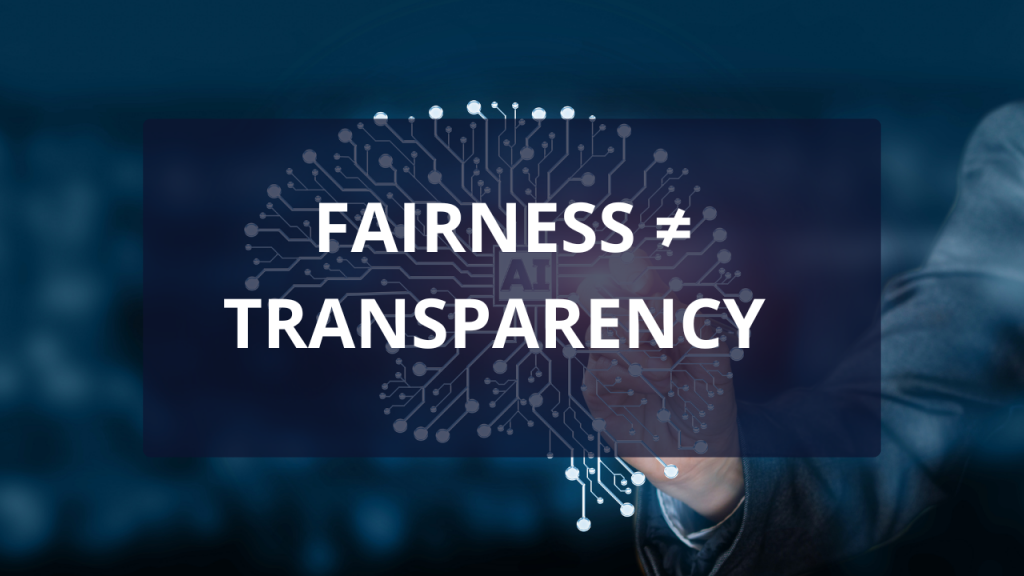
Fairness ≠ Transparency: Why Policies Miss the Hardest Part of AI Governance
When policymakers talk about responsible AI, one concept rises above all others: transparency. From the GDPR to the EU AI Act, transparency is invoked almost as a cure-all — the belief that if only AI systems are made more visible, they will automatically become more accountable, more trustworthy, even more fair. It’s an appealing idea. Transparency feels intuitive. We equate it with honesty, with being able to “see for ourselves.” If the system is open, then surely it must also be just. But here lies the first and most fundamental mistake. Transparency is not fairness. Making a system visible does not mean its outcomes are equitable. A system can disclose everything and still produce deeply unfair results.
This distinction matters, especially for product leaders. Because fairness in AI is not created in policy documents or audit reports — it is shaped in the day-to-day work of product management: in how problems are framed, which data is prioritized, which trade-offs are deemed acceptable, and which user outcomes are considered success.
Transparency tells us how a system works. Fairness asks whether it should work that way at all. And confusing the two risks leaving us with something worse than opacity: systems that are formally transparent but substantively unjust.
Why Transparency Dominates Policy Narratives
The reason transparency has become the centerpiece of AI governance is simple: it is administratively neat. Lawmakers can require disclosures, technical documentation, audit trails, and user notifications. These are tangible, enforceable obligations. A regulator can check whether a company published a report or labeled AI-generated content. Fairness, by contrast, is messy. It is contextual, contested, and difficult to measure. What looks fair in a credit scoring system may look discriminatory in a recruitment system. A decision that appears balanced in healthcare may feel arbitrary in education. Regulators tend to shy away from concepts that require subjective interpretation.
So the policy frameworks lean heavily on transparency as a proxy. If companies are forced to “open the box” — by sharing logic, data summaries, or impact reports — then fairness, accountability, and trust are assumed to follow. But here’s the tension: transparency is not self-executing. Information disclosure does not guarantee understanding. Knowing how an algorithm processes inputs does not necessarily empower a job applicant who has been unfairly rejected, or a consumer whose loan application was denied. In fact, too much information — presented without context — can overwhelm rather than enlighten. This is why transparency is attractive in theory, but often hollow in practice. It creates the impression of accountability without ensuring that accountability is delivered where it matters: in real-world decisions affecting people’s lives.
Why Transparency ≠ Fairness
The core problem with equating transparency and fairness is that they operate on different levels.
- Transparency is descriptive. It tells us how a system functions, what data it uses, and what process it follows.
- Fairness is normative. It asks whether those choices and outcomes are acceptable in a given social, cultural, or ethical context.
A company can disclose its algorithmic process in detail, but if the model still penalizes women in recruitment because it was trained on historically biased hiring data, the system is transparent but not fair. Conversely, a system may operate fairly in practice while remaining technically opaque — for example, when it is carefully calibrated through inclusive design and stakeholder involvement, even if the underlying mathematics are too complex for non-experts to follow. This distinction echoes what we see in organizational life more broadly: institutions often adopt practices not because they are the most effective, but because they are the most legitimate. In other words, disclosure and compliance become symbolic gestures. A company can say “we are transparent” without actually shifting the power dynamics or biases that drive unfair outcomes.
The risk is that transparency becomes a shield. By producing lengthy documentation, publishing technical papers, or providing dashboards that few people can interpret, organizations can claim compliance with regulation while avoiding the harder questions: Is this system equitable? Whose interests does it serve? What harms does it perpetuate?
Fairness is not achieved by showing people the inside of the machine. Fairness is achieved by changing what the machine produces.
The Role of Product Management in Bridging the Gap
If transparency is not enough, then where does fairness actually get built? Not in regulatory texts, not in compliance reports, but in the everyday decisions of product teams.
- Engineers ask: How do we implement this?
- Executives ask: Does this align with strategy and risk appetite?
- Lawyers ask: Are we compliant with the new regulation?
And in the middle stands the product manager.
The PM is the one responsible for translating principles into practice — ensuring that features are not just technically feasible, but ethically and socially sustainable. This role is far more than delivery management. It is expectation management, stakeholder orchestration, and outcome stewardship. When fairness questions arise — What counts as biased data? Who should be in the loop for sensitive decisions? How do we balance speed of release with the need for auditability? — they do not resolve themselves through transparency. They are resolved in trade-offs, prioritizations, and design choices. That is why product management must be central to responsible AI implementation. Policies can demand disclosures, but they cannot script discovery processes, shape user journeys, or run retrospectives. Those are the rhythms of product practice — and they are precisely where fairness either emerges or collapses.
The mistake many organizations make is treating compliance as a project to be checked off, rather than as an ongoing product practice. But fairness is not a milestone; it is a continuous outcome to be stewarded, tested, and re-tested across the lifecycle of an AI system.
From Compliance to Competitive Advantage
Most organizations today treat AI regulation defensively: a checklist of obligations to satisfy in order to avoid fines. Transparency becomes one more box to tick. But history shows us that the companies who thrive in periods of regulatory change are those who see beyond compliance. They recognize that how rules are implemented matters as much as whether they are followed. Here is the irony: because regulators cannot prescribe every detail of responsible AI practice, much of the implementation burden falls on individual organizations. That means the field is wide open. The models of “how to do it” are not yet set. In such a context, firms that experiment, document, and refine robust fairness practices will not only meet their obligations — they will become the examples others copy. This is where institutional dynamics come in. When the pressure to appear legitimate grows, organizations often adopt the practices of visible leaders. This is not efficiency-driven; it is reputation-driven. The first movers define the template.
For forward-looking companies, this is an extraordinary opportunity. By investing now in product practices that embed fairness — stakeholder-inclusive discovery, bias-aware data management, ethical checkpoints in delivery — they can shape the very standards the rest of the market will follow. Fairness, in other words, is not just an ethical choice or a compliance requirement. It is a source of competitive advantage. It positions a company not as a reluctant follower of regulation, but as a trendsetter in an emerging field where credibility and trust are scarce and highly valued.
Conclusion
Transparency will remain a central feature of AI regulation. But if we confuse it with fairness, we risk mistaking visibility for justice. Disclosure alone cannot resolve bias, mitigate harm, or ensure equitable outcomes. Fairness emerges through the messy, iterative, and deeply contextual work of product management: defining outcomes, shaping discovery, prioritizing trade-offs, and involving the right stakeholders at the right time. These are not functions regulation can prescribe — they are practices organizations must develop and own.
This is why the implementation of the AI Act and related policies will look less like a deterministic legal rollout and more like a constructivist process. Each organization will interpret, adapt, and improvise its way toward legitimacy. And in that process, the companies who go beyond minimal compliance and invest in fairness as a product practice will set the benchmarks others imitate. For product leaders, this is both a challenge and an opportunity. The challenge is that regulation leaves many questions unresolved, placing responsibility squarely on the shoulders of organizations themselves. The opportunity is that those who lead with integrity, creativity, and strong product stewardship will not just comply — they will shape the norms of responsible AI for an entire industry.
And that, ultimately, is the promise of product leadership in this space: not to treat regulation as a ceiling, but as a floor on which to build better, fairer, and more trusted AI systems.
